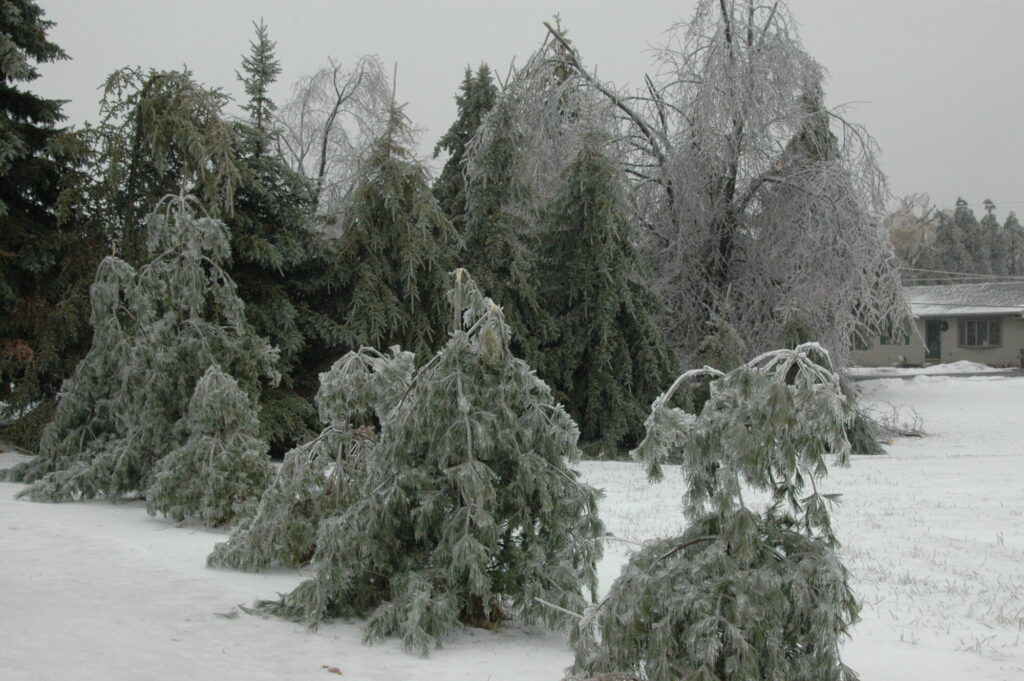Winter brings a picturesque landscape, often characterized by glistening ice formations on trees. While this sight may be beautiful, the impact of ice accumulation on trees can be severe, leading to damage that requires careful attention and skilled restoration. In this blog post, we’ll explore the essential aspects of preventative pruning to mitigate ice damage and the proper restoration techniques to rejuvenate trees post-ice storm.
Preventative Pruning: Strengthening Trees Against Winter Ice
Trees are resilient, but winter ice storms can take a toll on even the hardiest of them. To minimize the risk of damage, preventative pruning becomes crucial. By selectively pruning branches before winter sets in, arborists can reduce the overall weight and wind resistance of the tree, making it less susceptible to ice accumulation. This preemptive measure not only safeguards the tree but also prevents potential hazards to nearby structures and passersby.
Proper timing is essential for preventative pruning. Late fall or early winter, before the ice season commences, is the ideal period. Removing weak, dead, or overextended branches during this time helps maintain the tree’s structural integrity, minimizing the risk of breakage under the added weight of ice.
Restoration Pruning: Nurturing Trees Back to Health
Despite our best efforts, trees may still succumb to the weight of ice, resulting in damage. The process of restoration pruning becomes paramount in such instances. The techniques of restoration pruning involve carefully assessing the extent of damage and strategically removing broken or damaged branches to encourage healthy regrowth.
There is a strong emphasis on the importance of patience in the restoration process. After an ice storm, trees may appear irreparably harmed, but with the right care, many can recover. Restoration pruning not only improves the tree’s aesthetics but also promotes its overall health and longevity.
Understanding the Impact of Ice and Storm Damage on Trees
Ice storms pose a dual threat to trees: the weight of accumulating ice and the accompanying wind gusts. When ice accumulates on branches, it can lead to bending and breaking, causing significant damage. Moreover, the force of the wind can exacerbate these effects, turning a winter storm into a potential arboreal disaster.
Wood fiber composition varies significantly among different tree species. Certain tree species, including Siberian elm, silver maple, willows, and numerous evergreens, are particularly susceptible to damage from ice storms. This susceptibility is closely tied to the unique characteristics of their wood fiber and overall structure. Evergreens face increased susceptibility to ice storm damage due to their larger surface area, providing more space for ice accumulation. Adding to the challenge, many evergreen species possess wood fibers that are more brittle, making them more prone to breakage than bending.

Expert Pruning Solutions
Homer Tree Care stands ready to provide expert pruning solutions. With a team of skilled arborists, we specialize in both preventative pruning and meticulous restoration techniques. Our goal is to ensure the health and longevity of your trees, enhancing the safety and beauty of your outdoor space.
As winter approaches, taking proactive measures through preventative pruning can fortify your trees against the potential damage caused by ice accumulation. However, when nature takes its course and damage occurs, the art of restoration pruning becomes crucial. By understanding these principles and seeking professional care when needed, you can ensure your trees withstand the winter elements and thrive for years to come.
Contact Homer Tree Care for all your pruning needs before and after ice damage. Our team is dedicated to preserving the beauty and health of your trees, providing tailored solutions for every situation.

